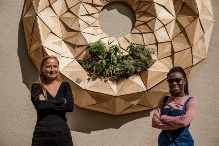Marie Davidová, Leonie K. Fischer and Martha Teye presented and published a paper about their recent prototype built within the Cluster of Excellence IntCDC at the Relating Systems Thinking 11 (RSD11) symposium.
The work-in-progress project relates ecosystems with socio-technological systems (STS) in urban environments. It focuses on the development of more-than-human cities of the post-Anthropocene. Through a prototypical urban intervention, POL–AI, built from responsive wood, we aim to support more-than-human edible and habitable landscapes on existing buildings, thus supporting urban connectivity also for wild nature elements such as insects. The prototype covers elements that are often used in so-called insect hotels, pollinator gardens and artificial intelligence (AI) monitoring systems for pollination, garden ecosystems and responsive wood performance of habitats. Further on, this prototype will include QR codes, leading to its own Do-it-Yourself (DIY) recipe and a citizen-science mobile application, Spot-a-Bee' that informs the AI image recognition database when the pollinators are pollinating. Therefore, the project becomes generative. The prototype has been developed through gigamapping, which is a Systems Oriented Design tool for synergising the multi-centred perspective of related stakeholders. It is being robotically fabricated. However, making its iterations in makers' labs or even on a mitre saw should be easy. We have recently faced high extinction rates in wild species and their habitats. The “Planetary Boundaries” model clearly points to biodiversity loss as one of the most alarming global issues. Yet for some species, urban environments can offer better habitats than poisoned agricultural land, however, the connectivity between urban habitats is often low. Therefore, urban adaptations for more-than-human architecture are necessary to counteract biodiversity loss.
More information about the paper here.


